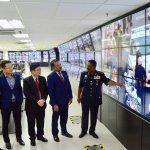
Facial recognition is becoming more and more important everyday. Source: Shutterstock
Citizens might worry, but facial recognition is making the world safer
FACIAL RECOGNITION might seem like the kind of technology that governments use to police its citizens — tracking where they go and who they associate with. It’s also a technology that enterprises can use to secure their sprawling offices, factories, and other public and private facilities.
And although citizens worry about it, the technology or its use for surveillance purposes isn’t a bad thing at all.
In fact, with governments and businesses in the US, UK, UAE, and even China investing in sophisticated facial recognition and security solutions, the world is set to become safer and more secure.
Most recently, China announced that its traffic police will be launching a nationwide program to identify drivers and vehicles that flout motor laws.
In the US, Customs and Border Protection officers in various cities have deployed facial recognition trials and plan to scale up projects in the near future given their reliability, effectiveness, and success.
Basketball and football stadiums that attract hundreds of thousands of fans every year are also starting to use the technology to track people and their movements to make security personnel more effective and help them focus their attention on potentially suspect behavior.
Stop worrying about facial recognition
“This is not a surveillance program. We are not just hanging a camera in an airport and randomly identifying people … as they’re walking through. The biometric really becomes as simple as validating the information we’ve already received,” US Deputy Executive Assistant Commissioner John Wagner told Nextgov in an interview about the use of facial recognition in airports.
“There’s no new information we’re requiring of a person other than taking their photograph and comparing it to a photograph they’ve already given us.”
That’s pretty much the long and short of facial recognition technology in the world of surveillance.
Outside the airport, in car parks and sports stadiums, enterprises tend to use an added layer that profiles standard and unusual behavior and raises an alarm for events that security personnel need to check.
An example of this would be if a person enters a parking lot with a bag and leaves the bag next to a car or pillar, the bag will be identified as an unidentified object and guards would be directed to the site to evaluate the situation.
Further, contrary to popular belief, enterprises and governments don’t tend to save video feeds forever. The surveillance is intended to help with real-time assessment and incident response and information is usually deleted periodically.
Technology makes urban spaces safer
Facial recognition makes urban spaces safer and helps law enforcement agencies more effective.
China, for example, recently said that the technology allowed it to apprehend a suspect in a crowd of 60,000 people attending a Jacky Cheung concert at the Nanchang International Sports Center.
Truth be told, facial recognition has helped apprehend quite a few suspects at concerts in China, including a trader wanted for non-payment of US$17,200 worth of potatoes. In this instance, the suspect was nabbed among 20,000 concert-goers at the Jiaxing Sports Stadium.
While not much has been reported by other governments in terms of results, the reality is that facial recognition doesn’t collect new information from people — citizens or employees. It only takes snapshots of people and compares them to photographs submitted via national IDs and employee records.
True, some agencies in the US are evaluating whether or not use of the technology amounts to an invasion of privacy in any way.
However, so long as the technology is only used to aid security professionals and law enforcement officers, not much should hinder its progress. After all, safety and security are the cornerstones of a stable, thriving society.
READ MORE
- Ethical AI: The renewed importance of safeguarding data and customer privacy in Generative AI applications
- How Japan balances AI-driven opportunities with cybersecurity needs
- Deploying SASE: Benchmarking your approach
- Insurance everywhere all at once: the digital transformation of the APAC insurance industry
- Google parent Alphabet eyes HubSpot: A potential acquisition shaping the future of CRM




